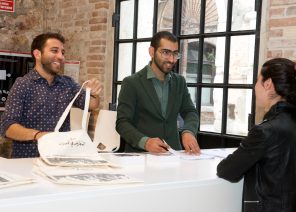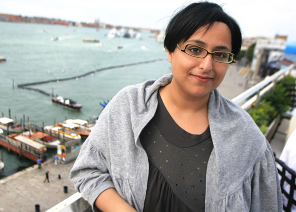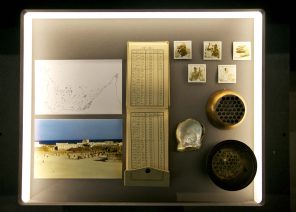2014
National Pavilion United Arab Emirates at the 14th International Architecture Exhibition of La Biennale di Venezia

Venice, Italy – June 5, 2014 – The National Pavilion United Arab Emirates (UAE) la Biennale di Venezia, commissioned by the Salama bint Hamdan Al Nahyan Foundation, and supported by the UAE Ministry of Culture, Youth and Community Development, opened ‘Lest We Forget: Structures of Memory in the United Arab Emirates’ located in the Arsenale – Sale d’Armi at the 14th International Architecture Exhibition of la Biennale di Venezia during the VIP Vernissage days.
This exhibition is the UAE’s debut national pavilion at the International Architecture Exhibition. It is curated by Dr. Michele Bambling in collaboration with the research team of architects Adina Hempel and Marco Sosa and adviser Hanan Sayed Worrell.
“For the UAE’s first participation at the International Architecture Exhibition we are pleased to present this unique architectural narrative of our nation showcasing the journey of growth and development of our country. Today, we are one of the fastest growing countries in the world, and we are proud that our modernity is deeply rooted in heritage and tradition as evident in the story of the exhibition,” noted Sheikha Salama bint Hamdan Al Nahyan, Founder of the Salama bint Hamdan Al Nahyan Foundation.
‘Lest We Forget: Structures of Memory in the United Arab Emirates’
Responding to the theme ‘Absorbing Modernity: 1914-2014’ set by the curator of the 14th International Architecture Exhibition, Rem Koolhaas, ‘Lest We Forget: Structures of Memory in the United Arab Emirates,’ presents the seminal findings of a larger initiative to archive the history of architectural and urban development in the UAE over the past century. With a concentrated emphasis on the 1970s-1980s, the exhibition examines how public and residential architecture, built within a rapidly expanding urban context, shaped the newly established federation and prepared the foundation for its emergence on a global stage.
The exhibition is based on the concept of an open archive, providing the viewer a platform to engage with primary material that illuminates the historic development of cities in the UAE and collective memory. Set within a century-long chronology, structured into four distinct historical phases, the exhibition explores the transmission of architectural traditions from indigenous through modern to contemporary architecture.
“I wanted to create an interactive exhibition that encourages exploration and the rewards of discovery through an open archive. I also wanted to open a conversation between architects and urban planners with citizens who experience the built environment of cities in the UAE,” explained Bambling. “Much of the diverse material has been gathered, created for the exhibition or shown to the public for the first time — content that is typically hidden within in files of architectural and engineering firms, and in municipal and federal archives, in Emirati family photo albums, on travelers’ post cards, and in photographic collections.”
The four periods are as follows:
- 1914 – 1949 – Vernacular Architecture. Examining indigenous architectural traditions of the UAE
- 1950-1970 – Infrastructure and Urban Development. Exploring the early urban master plans of the Emirates of Abu Dhabi, Dubai and Sharjah
- 1971-1994 – Structures of Modernity. Showcasing key buildings from the UAE’s initial encounter with modernity following the union of the Emirates
- 1995-2014 – Retrospective and Innovation. Highlighting conservation and adaptive reuse efforts aimed at preserving modern heritage buildings and planning for a sustainable future
Architectural and urban developments within these four time periods are demonstrated via three main components of the exhibit. The first, archive drawers hold primary material such as architectural and engineering renderings, official documents, industry aerial photographs, historic photographs, family snapshots and oral histories.
The second component is filmed conversations projected on large screens above the archival drawers. The conversations bring together the UAE’s leading professionals in architecture, engineering, education, conservation and culture to share their experience and perspective on the history of architecture and urban development in the UAE. Notable participants include engineer Rashad Bukhash, Director of Architectural Heritage Dubai Municipality & Chairman of Architectural Heritage Society; Dr. Yasser Elsheshtawy, Associate Professor of Architecture, United Arab Emirates University Al Ain; Mel Stewart, Civil Engineer & Special Advisor at Halcrow; Dr. Frauke Heard-Bey, author, From Trucial States to United Arab Emirates; David Heard, author of From Pearls to Oil: How The Oil Industry Came to the United Arab Emirates, and Peter Jackson, RIBA, Architectural Advisor, HH Ruler’s Office, Sharjah.
A third significant element of the exhibition is the info-graphic maps, figure-ground diagrams and a comprehensive timeline. The timeline runs the length of the exhibition and corresponds to the four archival drawer units. The timeline features the significant buildings of the UAE within the context of regional and international political and economic events as well as architectural developments. A map conveys the key architects and engineers who worked in the UAE during the modern era and figure-ground diagrams demonstrate the rapid pace of urban development in the three principle cities of the UAE: Abu Dhabi, Dubai and Sharjah.
Design and Further Contributions
The exhibition was designed by the curator in collaboration with the Italian architectural firm Milk Train, who has a wide portfolio of projects including architecture and design ventures, residential buildings and art installations and curatorship. The architects of Milk Train were part of the team that designed the exhibition for the Italian pavilion at the 13th International Architecture Exhibition in 2012.
A UAE-based boutique photographic and video agency, seeing things, filmed and edited the filmed conversations. WTD Magazine, a UAE-based architecture and design publication designed the info-graphics, exhibition catalog and promotional material.
Venice Internship
Initiated in 2009, the Venice Internship is a specialized internship program offering a range of opportunities to young Emiratis and long-term residents of the UAE, who are keen to engage with culture and arts at the highest international level through a month-long internship in Venice, where they act as custodians and docents of the National Pavilion UAE. The program, which runs throughout the six-month duration of the Biennale, aims to create a legacy of highly skilled art practitioners in the UAE, by learning through interaction and exposure to top international artists, curators and industry leaders.
A select group of 19 Emiratis and long-term residents of the UAE will serve as exhibition managers and guides for the national pavilion throughout the duration of the 14th International Architecture Exhibition. To foster cultural exchange and enhance the interns’ local experience in Venice, eight Italian interns selected from the prestigious Ca’Foscari University in Venice will work side-by-side with their UAE counterparts at the pavilion. This aims to provide an opportunity for cultural exchange and engagement with Italian customs and language. The internship is supported by a comprehensive education program based on partnership with leading cultural institutions in Venice, and Ca’ Foscari University. The interns attend lectures and engage in assignments based on fieldwork conducted in the exhibitions of the Biennale and throughout the myriad cultural institutions of the city.
The National Pavilion United Arab Emirates la Biennale di Venezia
The National Pavilion UAE was established to endorse the UAE’s contemporary art practices on an international platform and provide a foundation to support the nation’s diverse and developing cultural scene.
The UAE’s participation at la Biennale Di Venezia commenced in 2009 with a national pavilion at the 53rd International Art Exhibition, and has continued in subsequent editions of the art exhibition since. 2014 marks the UAE’s first participation at the International Architecture Exhibition.
The commissioner of the national pavilion, Salama bint Hamdan Al Nahyan Foundation, is a philanthropic, non-profitable organization with a deep commitment to developing and supporting the art and culture industry in the UAE. It is the family foundation of Her Highness Sheikha Salama bint Hamdan Al Nahyan.


